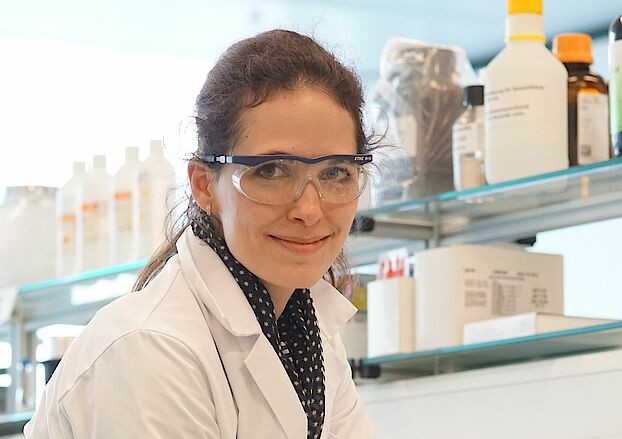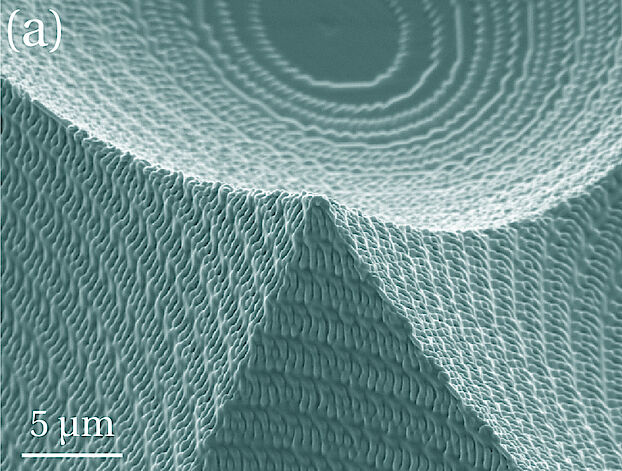/ Erfolgsgeschichten
Structure is everything

«In Zusammenarbeit mit verschiedenen Partnern untersuchen wir den Einsatz modifizierter Kunststoffoberflächen für die unterschiedlichsten Anwendungen», Dr. Sonja Neuhaus, Projektleiterin im Nano-Argovia-Programm, Hochschule für Technik (FHNW)


How different surfaces affect properties
Nature is filled with examples of surfaces that have particular properties due to their structure. A special nano- and microstructure, for instance, allows butterfly wings to shimmer in different colors without any pigments at all. Some leaf surfaces cause water and dirt to simply roll off them, and cicada wings have a certain surface structure that stops microorganisms taking up residence. Research teams around the world are investigating these types of phenomena and attempting to simulate them for a vast range of applications. Some of the interdisciplinary teams in current Argovia projects are also working on producing special surfaces to suit their specific needs. The RepAll and Nano Cicada Wing projects are aiming to develop a fairly rough, structured surface that prevents water and bacteria from sticking to it. Researchers in the SurfFlow project, by contrast, are trying to produce the smoothest surfaces possible for the small polymer lenses they are developing for optical applications.
Nothing should stick
The team in the RepAll Argovia project is laying the groundwork for producing surfaces that make water and other liquids roll off them – very similar to what happens with lotuses and duck feathers. Researchers working under project leader Dr. Sonja Neuhaus from the FHNW School of Engineering in Windisch are using nature as their model. They are testing out various ways of producing structured and chemically modified surfaces that repel various liquids.
The researchers began by using electron beam lithography to make stamps that then allowed them to transfer structures onto polymer films via roller and hot stamping. This results in synthetic surfaces with patterns of tiny hollow and solid pillars that are much less wettable than solid surfaces are. To measure the wettability, the team recorded the contact angle between the drops of liquid and the surface. The lower the interaction between the liquid and the surface, the bigger the contact angle (also known as the wetting angle). The researchers also used wire mesh as a stamp to make surfaces more repellent to various liquids and thus achieve their aim of significantly reducing wettability.
Improvements through chemical modification
For a variety of applications, it is not only important to increase the contact angle, but also to reduce the roll-off angle (which indicates how much a surface needs to be tilted before droplets roll off it). Initially, structuring the surfaces increased the roll-off angle. Chemically modifying the surfaces, however, reduces the incline needed to make the droplets roll off. To this end, the researchers produced fluid-like surfaces which improved the roll-off of both water and oil.
The interdisciplinary team of researchers from FHNW, PSI, and the company Cellpack Packaging AG have produced structured synthetic surfaces that cause a variety of liquids to run off well. However, achieving the desired effects is a complex process and difficult to transfer to an industrial scale. Nonetheless, researchers will continue down the path they are currently on and will intensify their research into combining structuring methods with chemical functionalization.
As antibacterial as cicada wings
Within the Nano Cicada Wing Argovia project, researchers from the University of Basel, the FHNW School of Life Sciences in Muttenz, and the company DSM in Kaiseraugst want to equip surfaces with bactericidal properties without using antimicrobial active substances. They are basing their work on cicada wings, which have a special surface structure that inhibits bacterial growth. The wings are peppered with nano-sized, pillar-like structures that make the wings highly hydrophobic but allow bacteria to stick to them well – so well, in fact, that when the tiny pillars move, the bacteria die because their cell membranes stretch and ultimately rip. This bactericidal effect is based on a purely mechanical principle, not on bactericidal or antibiotic substances. The hope is that bacteria will be slower to develop resistances to this mechanical mechanism.
Structuring prevents adhesion
Other groups have successfully simulated this principle on silicon and titanium surfaces, and now the Nano Cicada Wing researchers want to apply the findings to synthetic surfaces, as they offer a wide spectrum of possible applications. To do this, the team working under project leader Professor Dr. Ernst Meyer started by using low-energy plasma etching to produce polymer surfaces with nanometer-sized columns arranged with varying degrees of compactness. Unlike the surface’s natural prototype – the cicada’s wings – bacteria in liquids survived contact with the structured polycarbonate surface to the same extent as bacteria that came into contact with a non-structured control surface. However, the number of bacteria that adhered to the surface fell significantly – by 60% in the case of the intestinal bacterium E. coli. In situ studies using an atomic force microscope showed that only a small number of the bacteria died on the structured surface. Some of the bacterial membranes were destroyed. However, as the process takes many hours, the researchers suspect that the bacteria were more likely to have died from starvation than from the membrane rupturing when the columns moved. Experiments conducted so far suggest that the structured polymer surfaces have a relatively minor antibacterial effect. Experiments with materials such as titanium and tungsten, however, show a larger effect. In future, researchers will investigate applications in the field of dental implants in collaboration with the University Center for Dental Medicine Basel (UZB).
As smooth as possible
While the RepAll and Nano Cicada Wing projects are aiming for structured surfaces, researchers in the SurfFlow Argovia project want to make polymers with very smooth surfaces. The team working under project leader Dr. Helmut Schift of the Paul Scherrer Institute (PSI) are working with the kind of optical polymer microlenses that are found in devices such as smartphones. To produce larger quantities of these small lenses, the researchers begin by using 3D lithography to make master structures out of thin layers. However, the master structures and the resulting lenses have rough surfaces that are problematic for optical applications. The SurfFlow researchers from PSI, the FHNW School of Engineering in Windisch, and the company Heptagon are investigating how they can subsequently smooth out the surface without changing the underlying layers or affecting the shape of the lenses.
Just the surface, not the shape
In working toward their goal, the researchers applied the TASTE method that was developed at PSI. This involves selectively changing the material properties of the sample section that is due to be changed at a later stage. The researchers illuminated the master structure with short-wave UV light to modify the polymers. This also alters the temperature at which these polymers change from a solid state into a thick molten mass (glass transition temperature). The researchers have now succeeded in lowering the glass transition temperature of a thin surface layer. When the sample is then warmed to a specific temperature on a hotplate, only the treated surface starts to melt a little. It becomes smoother, while the shape and the underlying layers remain practically unchanged. This method allowed the SurfFlow researchers to reduce the roughness of their polymer lenses in the nanometer scale, while retaining structural details of a few micrometers in size.
